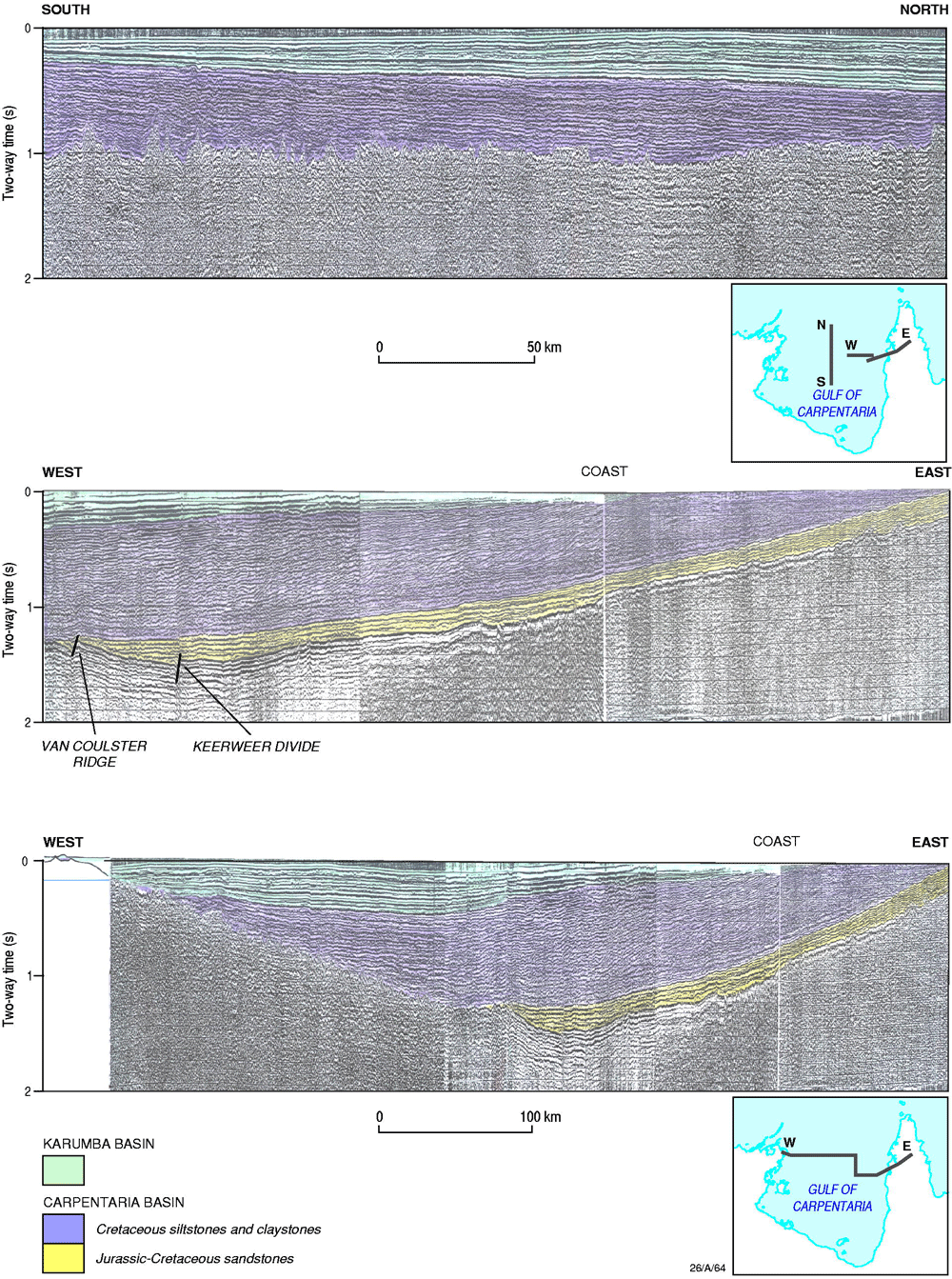Carpentaria Basin
Last updated:27 June 2014
Basin Details and Geological Overview
The Jurassic-Cretaceous intracratonic Carpentaria Basin lies beneath the Gulf of Carpentaria in offshore northern Australia, and extends onshore in Queensland and the Northern Territory. It is overlain by Tertiary sediments of the Kurumba Basin. Unlike the age-equivalent Eromanga and Surat basins which overlie large and thick older sedimentary basins, the Carpentaria Basin rests mainly upon an erosional surface of deformed Proterozoic rocks. Only a small portion of the offshore part of the basin overlies pre-Jurassic sedimentary rocks (Bamaga Basin).
Offshore, the Carpentaria Depression in the Weipa Sub-basin is the major depocentre of the basin. The laterally extensive sedimentary succession is typically thin with a maximum thickness of about 1800 metres offshore. Much of the Carpentaria Basin succession includes fine-grained, lithic marine rocks which are rarely preserved in outcrop. However, the Middle to Late Jurassic older units are predominantly quartz sandstones and are preserved to varying degrees along the eastern and southern margins of the basin. Within these basal units, thin coal seams and widespread reservoir quality sandstones have been the focus for coal and petroleum exploration. Shallow marine glauconitic sandstones of Neocomian age are overlain by mostly fine-grained Aptian to Albian marine clastics that contain potential source and seal facies. The bituminous claystones of the Albian Toolebuc Formation have excellent oil-prone source rock quality. These rocks are within the early stage of the oil generation window in the offshore part of the basin, as shown by drilling result from the Duyken-1 well, which is the only well drilled in the offshore part of the basin.
The Carpentaria Basin formed the northern part of the Great Australian Superbasin that also included the Eromanga and Laura Basins. Middle to Late Jurassic sediments within the offshore part of the basin were sourced from the east. During Late Cretaceous time, the margins of the basin were locally faulted, uplifted and eroded prior to the commencement of sedimentation in the overlying Karumba Basin.
- ProvExplorer - Capentaria Basin Details and Geological Overview
Regional Cross-sections
Key References
| Author | Year | Title |
|---|---|---|
| Burgess, I.R. | 1984 | Carpentaria Basin: a regional analysis with reference to hydrocarbon potential, Australian Petroleum Production and Exploration Association (APEA) Journal, Vol. 24 (1), pp. 7-18. |
| McConachie, B.A., Dunster, J.N., Wellman, P., Denaro, T.J., Pain, C.F., Habermehl, M.A. and Draper, J.J. | 1997 | Carpentaria lowlands and Gulf of Caprpentaria regions, AGSO Bulletin 240/Queensland Geology 9: North Queensland Geology, Bain, J H C, & Draper, J J, Chapter 9, 365-398. |
| McConachie, B.A., Stainton, P.W., Barrow, M.G., & Dunster, J.N. | 1994 | The offshore Carpentaria Basin - Gulf of Carpentaria, north Queensland, APEA Journal, 34 (1), 614-625. |
| McCulloc, M.T. | 1989 | Strontium isotope variations in single ostracod valves from the Gulf of Carpentaria, Australia, Geochimica et Cosmochimica Acta, 53 (7), 1703-1710. |
| Rhodes,eg | 1982 | Depositional model for a chenier plain, Gulf of Carpentaria, Australia, Sedimentology, 29 (2), 201-221. |
| Torgersen, T. | 1983 | General bathymetry of the Gulf of Carpentaria and the Quaternary physiography of Lake Carpentaria, Palaeogeography, Palaeoclimatology, Palaeoecology, 41 (3-4), 207-225. |
